Bubble chambers can detect charged particles passing through them, thanks to the properties of a special state of matter called superheated liquids. A liquid is said to be superheated when it is held above its boiling point whilst at intense pressures. Physicists fire a particle beam through the liquid and suddenly lower this pressure, rendering the liquid unstable. Particles travel through the liquid, displacing electrons from their nuclei. As the displaced electrons return to their nuclei, they release energy and induce localised boiling. Localised boiling produces tiny bubbles along the particle's trajectory, allowing for unfathomably tiny constituents of matter to be represented by a trail of bubbles each as large as a millimetre [1].
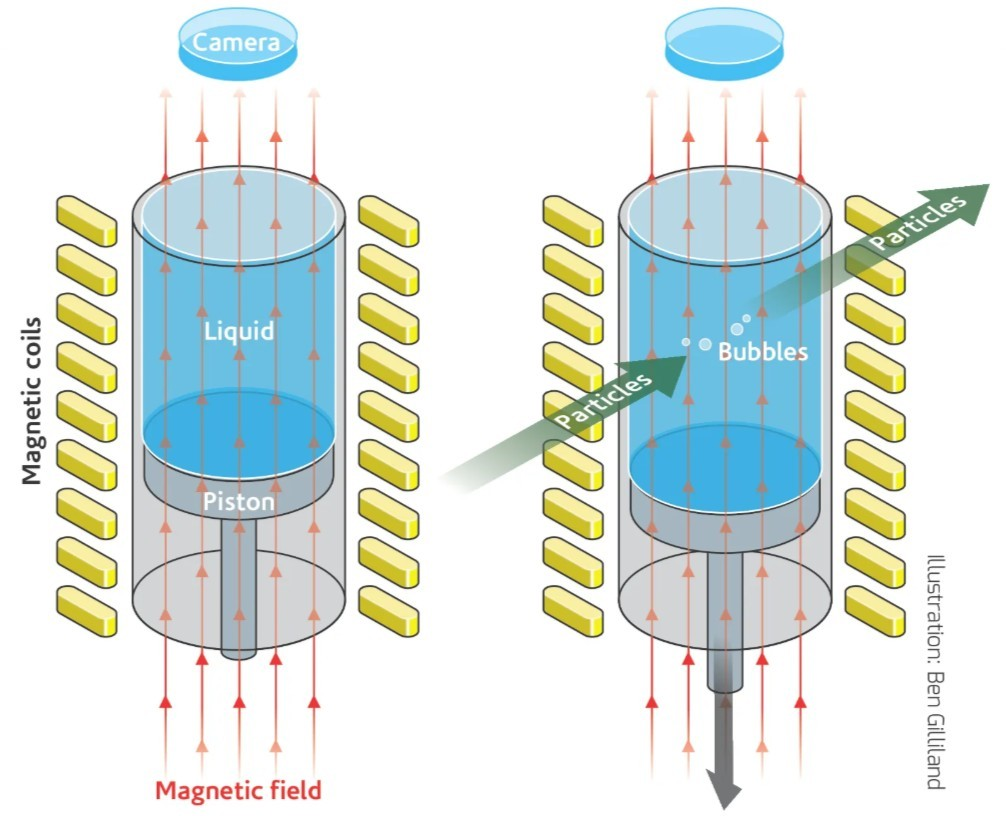
Diagram illustrating bubble chamber’s mechanism: Superheated liquid is immersed within a magnetic field at intense pressures. Pressure is relieved as a piston is pushed downwards – creating the conditions for bubbles to appear. The magnetic field allows for physicists to determine the momentum and charge of particles as they pass through.
Bubble chamber photograph taken from 1972 at the Big European Bubble Chamber

Bubble Chamber Data Preservation Initiative: Photograph was captured in the T209 experiment for CERN’s 2m HBC.
What might seem like a memorising juxtaposition of arcs, spirals and diverging lines is actually a well-ordered pattern from which physicists can extract a wealth of data. By visual recognition and identification of distinct features within the tracks, physicists can measure the momentum and energy to identify the products of collision.
Bubble chambers showcase the entire reaction chain, from the initial collision throughout the subsequent collisions and decay chains. Analysis of these tracks' physicists can determine the final products of a beam with known composition and energy.
By learning to recognise and interpret these visual patterns within the tracks, those less familiar with physics, can extract meaningful data, without extensive training or deep understanding of the underlying experimental apparatus. A now obsolete method of particle detection can provide an accessible introduction to the principles of particle detection [3].
Dr Andy Chisholm, an assistant professor of particle physics at the University of Birmingham, recognised the value of bubble chamber film as a teaching resource. In 2020, he launched ‘The Restoration and Revival of Bubble Chamber Film’ project, aiming to digitise these films, develop digital measurement techniques, and create a student toolkit. This educational resource will allow for students to simulate their own bubble chamber tracks and analyse their results, allowing for an introduction to the fundamentals of particle detection. Dr Chisholm said ‘It is much more intuitive than LHC data. Bubble chambers display the actual particles themselves, rather than digital signatures in aof complex electronic hardware’. These efforts are already underway, with 7800 film images digitisedfrom CERN’s 2m Hydrogen Bubble chamber experiment (HBC) with plans to add a collection from the Big European Bubble Chamber (BEBC) viewable in detail here.
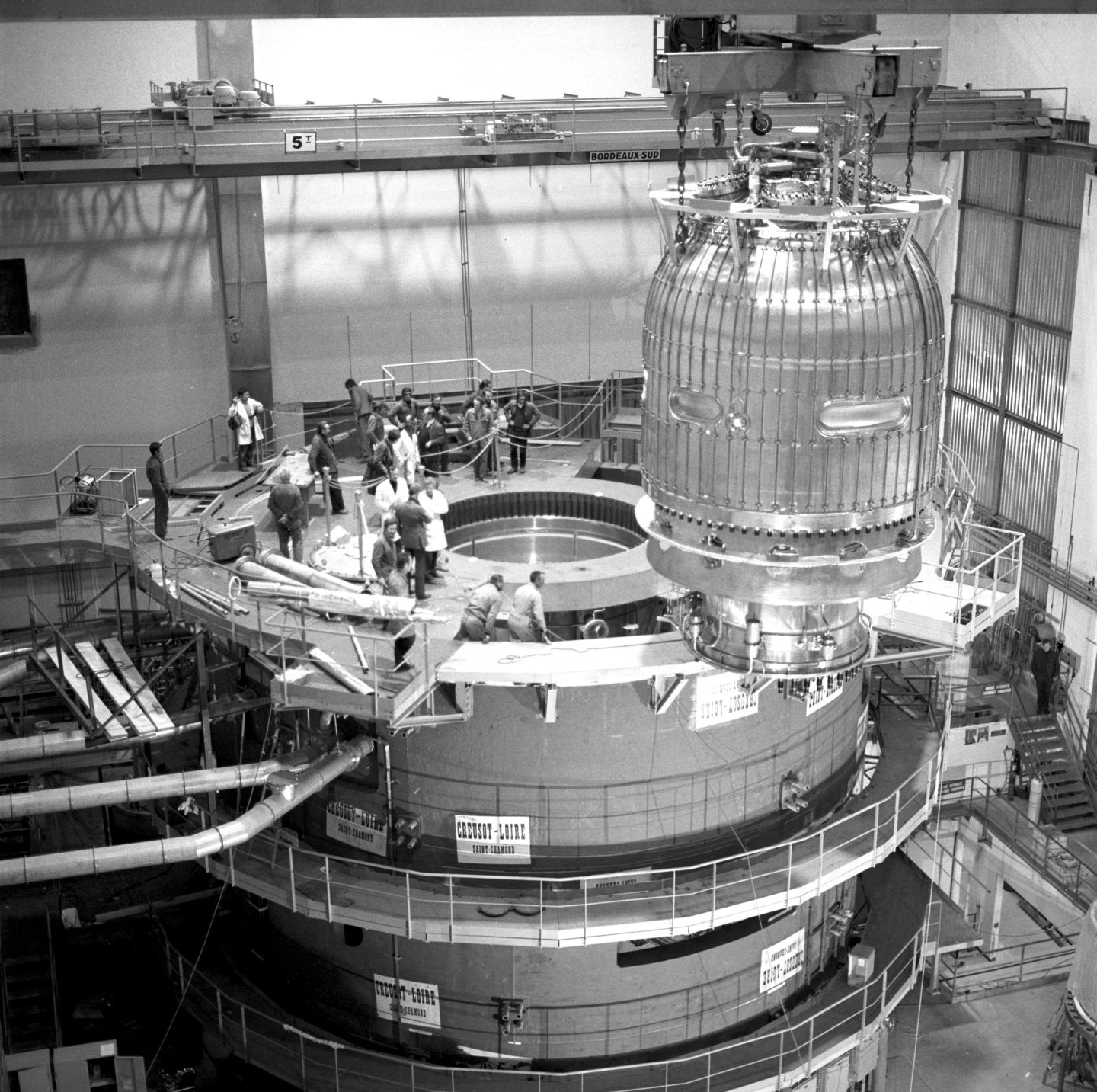
BEBC during Installation: Received beams from the Proton Synchrotron and later the Super Proton synchrotron at CERN. 5 stereo cameras interactions from these beams. Image credit – CERN Document Server
The project has come a long way since its beginning, thanks in part to archivists and several people he has enlisted, though it has largely remained a solo project throughout its duration. seed funding from STFC and the Royal Society; Andy was able to replace his commercial scanner for a more efficient apparatus, increasing the number of frames he could digitise each day from 48 to 2400!
Film reel is held taut and placed on a rotating motor, the motor passes the film reel over a vertical light box to increase the contrast of particle tracks to the transparent film. A high-resolution camera, aimed at the section of the film with particle tracks, then captures a photograph of the film [3]. Andy has collected tens of thousands of digitised bubble chamber frames using this method.
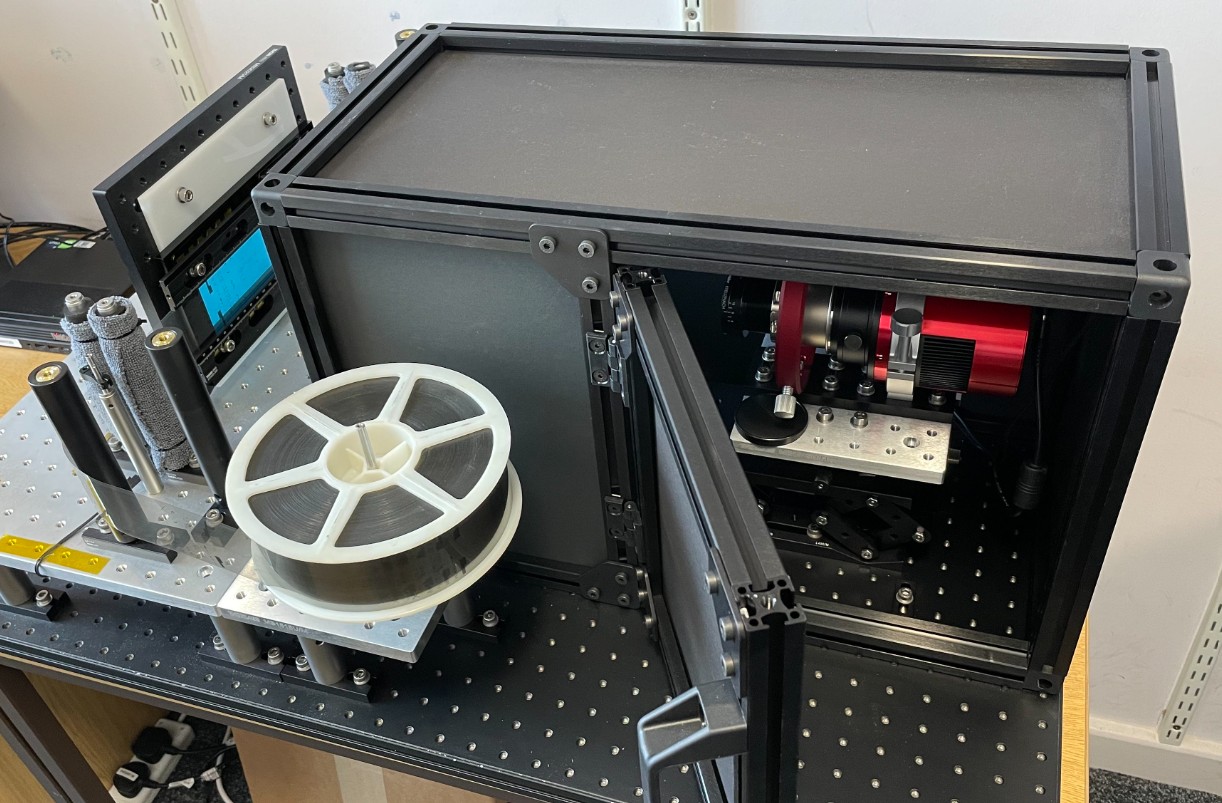

Left image: Digital Camera and illumination mechanism. Right image: Film feed mechanism. The camera shown in the left picture is present within the dark box.
The images and more detailed captions can be viewed at Bubble chamber data preservation initiative
Digitised bubble chamber film reels are visually appealing but useless without any knowledge of its properties. The first step to extract any data from these digital film reels is to identify the position of reference points, called fiducial marks. Fiducial marks have known coordinates that can be compared to track points, to aid in measurements. Since they are crossings etched into the glass of the camera windows, their position remains fixed in each film frame. However, the same cannot be said for the digitized images of the film. Each bubble chamber has unique dimensions, camera angles, liquid density, and types of glass used, all of which affect the position of the fiducial marks [2-3]. Each material has a different refractive index, bending light to varying degrees as it passes through. To accurately trace the light’s path and determine the position of the fiducial marks, it is crucial to understand the refractive index of each of these elements.
Thanks to archivists at CERN, technical documents from the 2m HBC experiment were able to provide these details allowing for Andy to create a simulation. This simulation can accurately trace the light’s path from cameras within the HBC to the point of interaction and predict the position of the fiducial marks within the experiment. Based on the known coordinates obtained from these documents, the simulation can determine the coordinates of fiducial marks on the digital image. Dr Chisholm hopes to enhance the accuracy of the simulation by gathering a larger dataset [4].
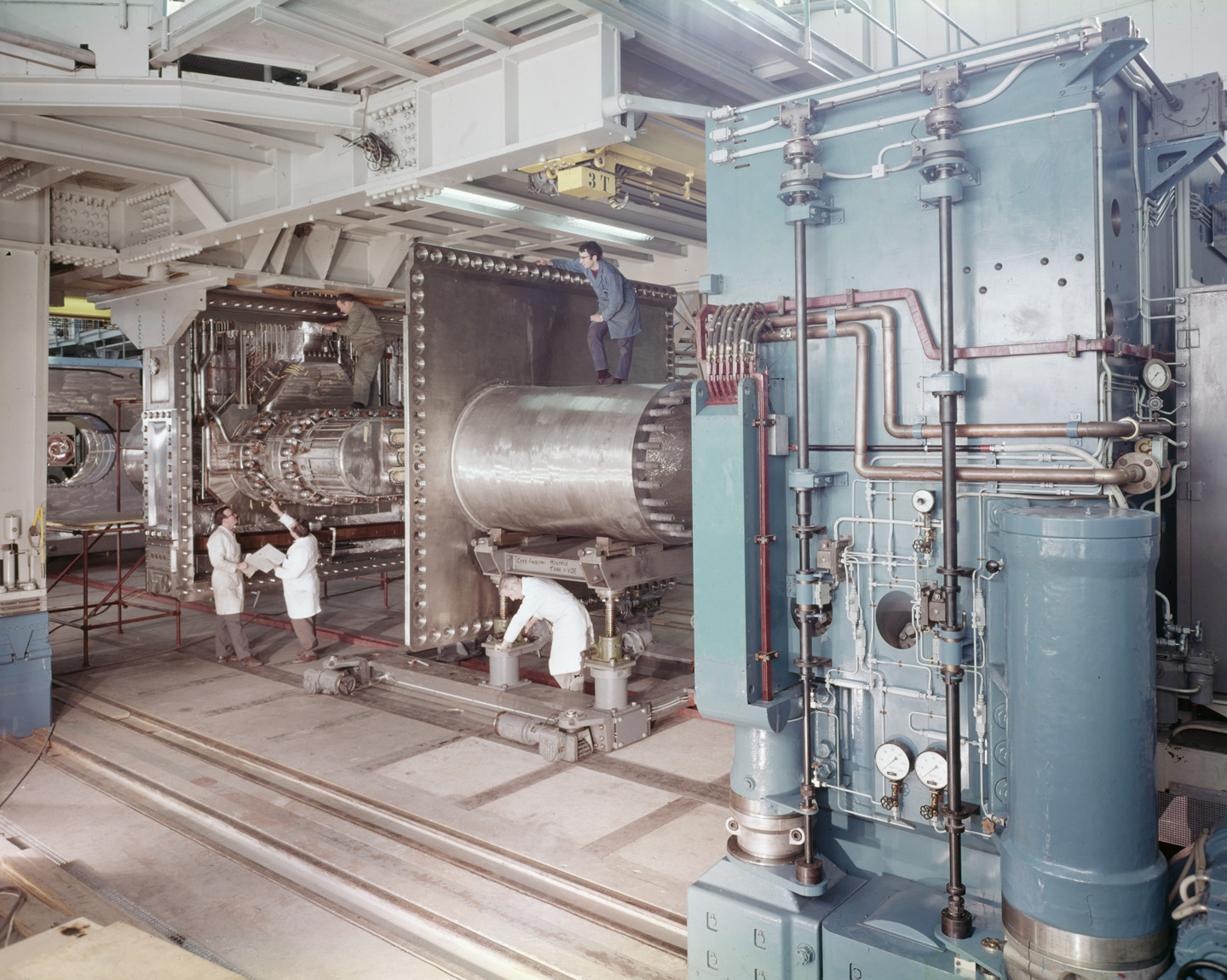
Dr Chisholm’s use of film reels from the HBC experiment raises the question, how did n academic in Birmingham come into possession of film reel recorded 5 decades ago in Switzerland?
CERN’s Hydrogen Bubble Chamber (1970): The bubble chamber began operation in 1964 but was disassembled to install various modifications and undergo a thorough cleaning. These photographs were taken as it was being reassembled.
How bubble chambers brought physicists together
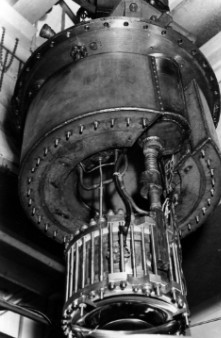
Bubble chamber experiments brought physicists from across the world to conduct experiments, helping to foster international scientific collaboration. The UK were early adopters of the technology, with Imperial College London constructing the first bubble chamber in Western Europe in 1957 [1][5][6]. and Liverpool Universities would soon follow with their own, constructing them to study the interactions from their particle accelerators.
Bubble chamber manufactured at Birmingham University (1958).
Image credit – Birmingham University
Data produced from these were often handled by analysis from the individual institutions, with only occasional exchange and domestic collaboration [6]. However, as bubble chambers grew in size, cost and complexity, the sheer volume of data became overwhelming and individual institutions could no longer afford to construct cutting-edge bubble chambers. To address this, institutions pooled their efforts together to interpret experimental results. multinational collaboration accelerated in the 1970s, as large experiments at CERN, Saclay and Argonne Laboratories began operation. These brought together groups as large as 100 physicists from up to 5 – 6 institutions [6].
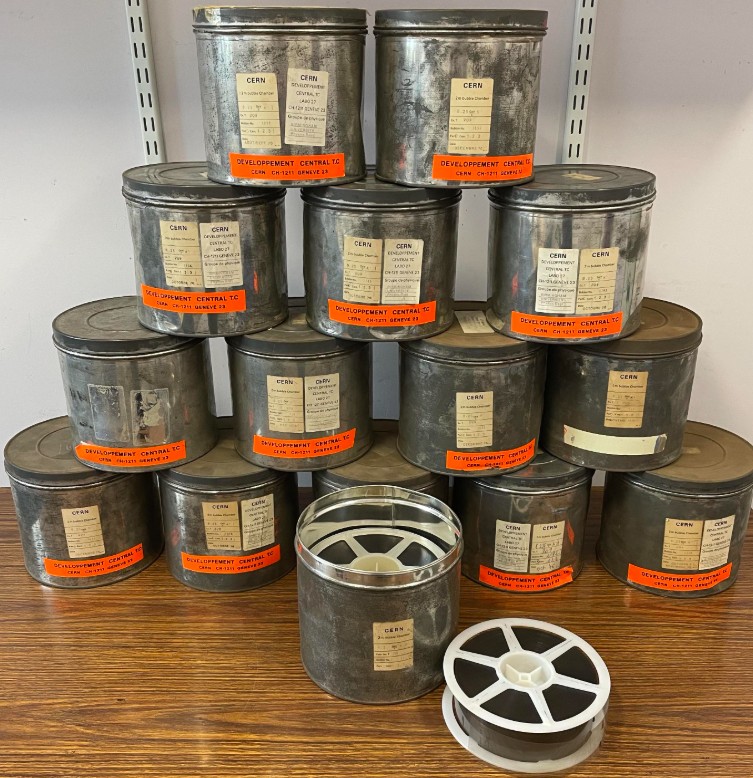
For instance, from the millions of photographs taken at the HBC, a sizeable portion was transported thousands of kilometres via plane, ferry or truck to the UK. They were then distributed to UK institutions such as RAL, University College of London and the University of Birmingham. Remnants of bubble chamber film exists across universities throughout the UK, thought they represent a small fraction of the original quantity as the majority were discarded after their analysis. A professor at Birmingham creatively repurposed these reels, handing them out as souvenirs during a university open day. Dr Chisholm received one, sparking the inspiration for his project [3].
Andy’s collection of Bubble chamber tins: Institutions across the UK have provided Bubble chamber film reels at his request.
Tricky track tracing
The most challenging aspect of Andy’s project thus far has been the development of a track reconstruction algorithm. This algorithm processes lines of computer code, that converts the raw data input into coherent measurements and useful data. Tracking particles is a fundamental function of particle detectors, modern detector experiments do so automatically, using advanced algorithms and data acquisition systems to essentially connect signals received as they traverse different segments of the detector.
Reconstructing particle tracks is difficult to automate as the desired tracks must be resolved amid the chaotic environment. Laboratories would develop semi-automated systems, overseen and regulated by humans, for analysis. For instance, in the 1970s, Birmingham University developed the Video Assisted Scan Table (VAST), a specialised semi-automated system to conduct track reconstruction. An operator would enlarge specific spots of a track, relaying the magnified image to a computer. A joystick was then used to search the digital image displayed for distinct track features. Failing to find any, the film would be scanned, and its measurements were inputted to a reconstruction algorithm. This algorithm comprised a series of equations, specific to each experiment, that would transform the inputted measurements into a set of probability values for various possible events, called hypotheses. From this set of hypotheses, physicists can estimate the mass, the momenta and even identify types of particles [1-2].
50 years later, Dr Chisholm has still not been able to simulate a fully automated track finding procedure. Any measurements obtained are reliant on manual mapping out of tracks. However, Andy has ambitious plans to automate this process using Artificial Intelligence (AI) programs [3]. Recent progress in machine learning, particularly image recognition, has been transformative for particle physics experiments, seeing widespread usage in the field, including forthe detection of elusive and rarely interacting particles such as neutrinos or dark matter. The swirling patterns of particles within the bubble chamber could provide a unique platform to train machine learning algorithms. Development of ML algorithms for this purpose could then be applied to other experiments, possibly advancing our search for dark matter.
Dr Chisholm’s project underscores the need to preserve scientific results. This is reflected in the policies of research institutions such as STFC’s Central Laser facility, Diamond Light Source and CERN, which requires experimental data be made available for reanalysis. Not only does this increase the longevity and reproducibility of scientific results, but in the case of bubble chambers, it preserves the rich heritage of UK research institutions.
Dr Chisholm is actively working to procure bubble chamber film reels and the corresponding technical documents for their analysis. Gathering these film reels is no easy task, as few remain from the millions of photographs once present in the UK, and finding those which align with his exacting specification is even more challenging. The project’s unique premise and potential applications has recently garnered interest from CERN and STFC’s Particle Physics Department. Dr Chisholm is optimistic that progress will soon accelerate. Let's hope so. Rather than allowing this unique scientific dataset to be discarded or forgotten, we can revive its contents to use as an educational resource and towards scientific applications.
[1] “Bubbles 40″ (1994) Nuclear Phys. B, Proc. Suppl, 36.
[2] CERN bubble chamber analysis handbook reference - M Jobes and H R Shaylor Data analysis techniques in High energy physics (1972) Rep. Prog. Phys. 35 1077
[3] Personal communication with Dr Andy Chisholm (University of Birmingham) for this article (2025)
[5] 1960 RAL Reports: Click the link and refer to the 1960 – 1961 RAL Report. Pg 7 – 13
[6] AIP study of multi-institutional collaborations: Phase 1, high-energy physics (1992) Joan Warnow-Blewett and Laura K. Maloney and R. Nilan - Link
Kolanoski, Hermann, and Norbert Wermes, Particle Detectors: Fundamentals and Applications (2020) Oxford Academic, Chapters 6, 16 - Link
Written by Kai Gregory, with input from Andy Chisholm who reviewed and edited the article.
